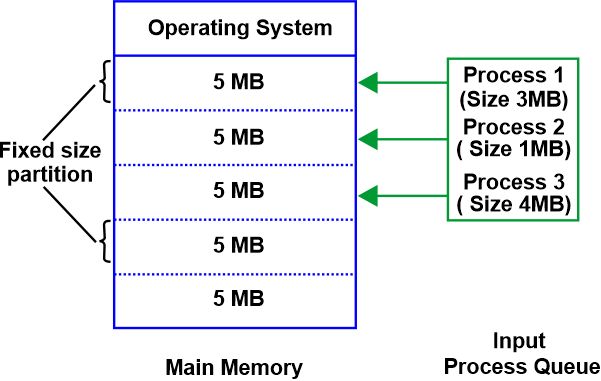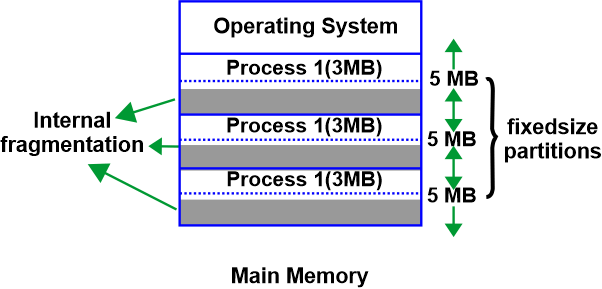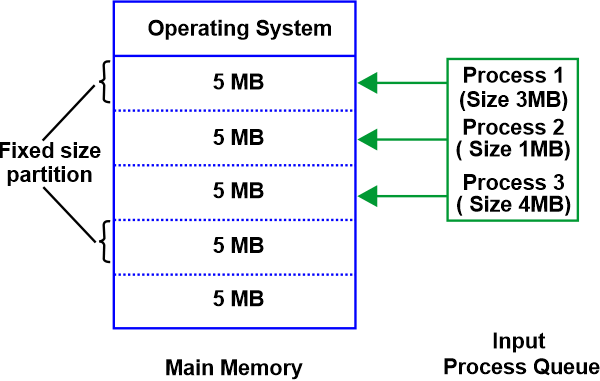Contiguous Memory Allocation in Operating SystemAllocating space to software applications is referred to as memory allocation. Memory is a sizable collection of bytes. Contiguous and non-contiguous memory allocation are the two basic types of memory allocation. Contiguous memory allocation enables the tasks to be finished in a single memory region. Contrarily, non-contiguous memory allocation distributes the procedure throughout many memory locations in various memory sections. We will explore more about contiguous memory allocation in this post, as well as its advantages and disadvantages. Contiguous Memory Allocation: What Is It?An operating system memory allocation method is contiguous memory allocation. What, however, is memory allocation? A software or process requires memory space in order to be run. As a result, a process must be given a specific amount of memory that corresponds to its needs. Memory allocation is the term for this procedure. Contiguous memory allocation is one of these memory allocation strategies. We use this strategy to allocate contiguous blocks of memory to each process, as the name suggests. Therefore, we allot a continuous segment from the entirely empty area to the process based on its size whenever a process requests to reach the main memory. Techniques for Contiguous Memory AllocationDepending on the needs of the process making the memory request, a single contiguous piece of memory blocks is assigned. It is performed by creating fixed-sized memory segments and designating a single process to each partition. The amount of multiprogramming will be constrained, therefore, to the number of memory-based fixed partitions. Internal fragmentation results from this allocation as well. Consider the scenario where a process is given a fixed-sized memory block that is a little larger than what is needed. Internal fragmentation is the term used to describe the leftover memory space in the block in the scenario. A partition becomes available for another process to run once a process inside of it has completed. In the variable partitioning scheme, the OS keeps a table that lists which memory partitions are free and which are used by processes. Contiguous memory allocation reduces address translation overheads, expediting process execution. According to the contiguous memory allocation technique, if a process needs to be given space in the memory, we must give it a continuous empty block of space to reside in. There are two ways to allocate this:
Let's examine both of these strategies in depth, along with their benefits and drawbacks. Fix-size Partitioning MethodEach process in this method of contiguous memory allocation is given a fixed size continuous block in the main memory. This means that the entire memory will be partitioned into continuous blocks of fixed size, and each time a process enters the system, it will be given one of the available blocks. Because each process receives a block of memory space that is the same size, regardless of the size of the process. Static partitioning is another name for this approach. 
Three processes in the input queue in the figure above require memory space allocation. The memory has fixed-sized chunks because we are using the fixed size partition technique. In addition to the 4MB process, the first process, which is 3MB in size, is given a 5MB block. The second process, which is 1MB in size, is also given a 5MB block. So, it doesn't matter how big the process is. The same fixed-size memory block is assigned to each. It is obvious that under this system, the number of continuous blocks into which the memory will be partitioned will be determined by the amount of space each block covers, and this, in turn, will determine how many processes can remain in the main memory at once. The degree of multiprogramming refers to the number of processes that can run concurrently in memory. Therefore, the number of blocks formed in the RAM determines the system's level of multiprogramming. Advantages A fixed-size partition system has the following benefits:
Disadvantages Although the fixed-size partitioning strategy offers numerous benefits, there are a few drawbacks as well:

Flexible Partitioning MethodNo fixed blocks or memory partitions are created while using this style of contiguous memory allocation technique. Instead, according on its needs, each process is given a variable-sized block. This indicates that if space is available, this amount of RAM is allocated to a new process whenever it requests it. As a result, each block's size is determined by the needs and specifications of the process that uses it. 
There are no partitions with set sizes in the aforementioned diagram. Instead, the first process is given just 3MB of RAM because it requires that much. The remaining 3 processes are similarly given only the amount of space that is necessary for them. This method is also known as dynamic partitioning because the blocks' sizes are flexible and determined as new processes start. Advantages A variable-size partitioning system has the following benefits:
Disadvantages Despite the variable-size partition scheme's many benefits, there are a few drawbacks as well:
Techniques for Contiguous Memory Allocation Input QueuesSo far, we've examined two different contiguous memory allocation strategies. But what transpires when a fresh process needs to be given a location in the main memory? How is the block or segment that it will receive chosen? Continuous blocks of memory assigned to processes cause the main memory to always be full. A procedure, however, leaves behind an empty block termed as a hole after it is finished. A new procedure could potentially be implemented in this area. As a result, there are processes and holes in the main memory, and each one of these holes might be assigned to a new process that comes in. First-Fit This is a fairly straightforward technique where we start at the beginning and assign the first hole, which is large enough to meet the needs of the process. The first-fit technique can also be applied so that we can pick up where we left off in our previous search for the first-fit hole. Best-Fit The goal of this greedy method, which allocates the smallest hole that meets the needs of the process, is to minimise any memory that would otherwise be lost due to internal fragmentation in the event of static partitioning. Therefore, in order to select the greatest match for the procedure without wasting memory, we must first sort the holes according to their diameters. Worst-Fit The Best-Fit strategy is in opposition to this one. The largest hole is chosen to be assigned to the incoming process once the holes are sorted based on size. The theory behind this allocation is that because the process is given a sizable hole, it will have a lot of internal fragmentation left over. As a result, a hole will be left behind that can house a few additional processes. Contiguous Memory Allocation's advantages and disadvantagesContiguous memory allocation has a range of benefits and drawbacks. The following are a few benefits and drawbacks: Advantages
Disadvantages
Conclusion
|
 For Videos Join Our Youtube Channel: Join Now
For Videos Join Our Youtube Channel: Join Now
Feedback
- Send your Feedback to [email protected]
Help Others, Please Share









